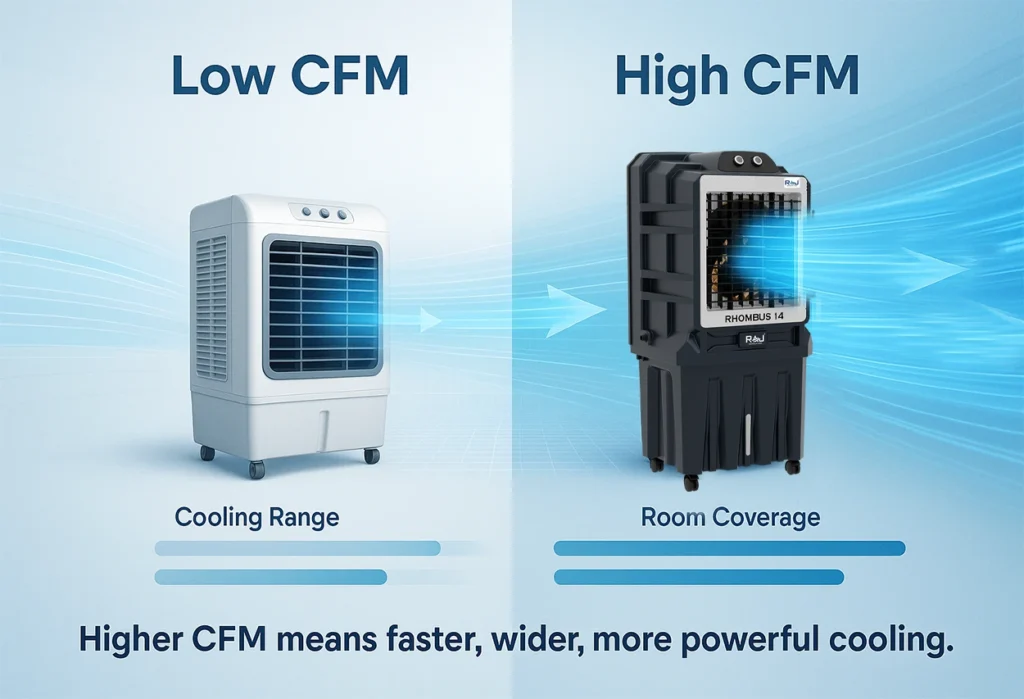When buying an air cooler, it’s easy to get caught up comparing tank sizes, motor strength, or pad quality. But there’s one factor that quietly defines how effective your cooler. The power of airflow is measured in CFM (Cubic Feet per Minute), and understanding it can completely change how you choose your next cooler. CFM is not just a technical number, but it is the key to knowing how much air your cooler can move to keep your space truly comfortable. Whether it’s a warm bedroom, a busy office, or a large workshop, mastering the basics of airflow can help you get the most out of your cooling experience.
Why Airflow Matters So Much
It’s annoying, isn’t it, to try to stay cool with a fan that hardly moves any air? The same holds true for air coolers. Your cooler won’t feel effective unless it’s moving enough air around the room, even if it has high-efficiency pads or chilled water.
Good airflow ensures that hot air is constantly being replaced by fresh, cool air. It prevents heat pockets from forming and helps maintain a consistent temperature throughout the room. Without proper airflow, you might find one corner of the room chilly while the other stays warm not ideal for comfort or energy efficiency.
What Exactly Is CFM?
CFM stands for Cubic Feet per Minute, and it simply measures how much air your cooler can move in one minute. Think of it as the “strength” or “capacity” of your cooler’s fan. The higher the CFM, the more air it pushes out, and the more area it can effectively cool.
For instance, a cooler with a CFM of 2,000 works best in offices or tiny bedrooms, whereas one with a CFM of 10,000 can be used in restaurants, warehouses, and large halls. The effectiveness of air coolers on evaporation is not only about cool air; it is also about how well the cooled air circulates. The proper CFM guarantees that the air reaches every area of your room, not just the area close to the cooler.
Why CFM Really Matters
Your air cooler’s CFM directly impacts how cool, cozy, and effective it feels. If the CFM is set too low, your room may feel warm farther away from the unit but comfortably cooled near it. An excessively high CFM can cause uncomfortable or noisy air pressure in a small space.
A balanced CFM gives you the best of both worlds: quick cooling, steady comfort, and lower electricity bills. It also ensures your cooler’s fan and motor don’t overwork, which helps extend the machine’s lifespan. Essentially, CFM is what connects comfort and efficiency get it right, and everything else falls into place.
How to Choose the Right CFM for Your Room
CFM = (Room Length × Room Width × Room Height) ÷ 2
This formula helps you calculate the minimum airflow your cooler should provide. For instance, if your room measures 10 ft × 12 ft × 10 ft, that’s 1,200 cubic feet. Divide it by 2, and you get 600 CFM, meaning you should choose a cooler with at least that much airflow capacity.
For small rooms (up to 200 sq. ft.), coolers between 600 and 2,000 CFM work perfectly. For medium spaces (300–600 sq. ft.), look for 3,000–5,000 CFM, and for large areas or semi-open spaces, go for 8,000–15,000 CFM or more. It’s all about matching the airflow to your room’s volume and ventilation.
Low vs. High CFM Coolers
Some coolers can function just fine with mild, steady airflow; others don’t require a lot of airflow. Low-CFM coolers are ideal for smaller, enclosed areas like bedrooms, offices, and study rooms. They consistently maintain a comfortable air quality, consume less energy, and produce less noise.
High-CFM coolers, on the other hand, are built for large or semi-open environments such as restaurants, halls, and workshops. They move a much larger volume of air, which helps maintain effective cooling even with higher ambient temperatures or crowds. The trick is to balance and choose higher CFM for larger spaces and moderate CFM for smaller, enclosed ones. More airflow isn’t always better; the right airflow is what matters.
How Raj Cooling Systems Gets Airflow Right
At Raj Cooling Systems Pvt. Ltd., airflow isn’t just a number, it’s an essential part of our engineering. Each of our coolers is designed with optimized CFM output to match specific room types and environments. From compact residential models to powerful commercial and industrial coolers, every design is tested to ensure the ideal balance between air volume, noise level, and energy use.
Our advanced fan systems and high-efficiency motors deliver strong, consistent airflow while using less electricity. Whether you’re cooling a cozy home office or a large workspace, Raj Cooling Systems ensures that every breath of air feels natural, refreshing, and evenly distributed.
Conclusion
CFM may sound like a technical term, but CFM is actually the most straightforward way to gauge an air cooler’s performance. It provides you with information about the cooler’s air movement efficiency, cooling speed, and comfort level. Look at the CFM rating of your next air cooler before you purchase it; this is the simplest method to make sure you’re getting the performance your space requires..
So, whether you’re setting up a new home, upgrading your office, or cooling a large business space, remember it’s not just about the size of the cooler, but the power of its airflow. Choose smart. Stay cool naturally. Explore Raj Cooling Systems’ advanced range of air coolers, designed for maximum airflow, energy efficiency, and long-lasting comfort.

